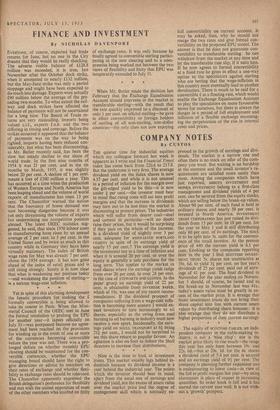COMPANY NOTES
By CUSTOS THE quieter time for industrial equities which my colleague forecast last week is apparent as I write and the Financial Times index has come back from 220.6 to 217.8. But the undertone is very firm. The average dividend yield on the index shares is now 4.37 per cent. and while it is not unusual in a period of inflation for the margin over the gilt-edged yield to be thin—it is now under + per cent.—the investor must bear in mind that rising costs will eat into profit margins and that the increase in dividends may turn out to be less than the market is discounting at present prices. The industries which will suffer from dearer coal—steel and cement in particular—will no doubt raise their prices, but it would be surprising if they pass on the whole of the increase. Is a dividend yield of slightly over 3 per cent. adequate for ASSOCIATED PORTLAND CEMENT in spite of its earnings yield of ' nearly 15 per cent.? The earnings yield is the investment test in a time of inflation and when it is around 20 per cent. or over the equity is generally a safe purchase for the long term. This applies to the market in steel shares where the earnings yields range from over 20 per cent. to over 28 per cent. in the case of STEWARTS AND LLOYDS. In the paper group an earnings yield of 22 per cent. is obtainable from INVERESK PAPER, which at 19s. was one of my recent recom- mendations. If the dividend prospect of companies suffering from a wage-cost infla- tion is becoming more austere I would ex- pect investors to turn increasingly to oil shares, especially as the swing from coal burning to oil burning in industry must now receive a new spurt. Incidentally, the earn- ings yield on SHELL TRANSPORT at 61 being 211 per cent., I would not be surprised to see this share return to popular favour. An agitation is also on foot to induce the Shell directors to increase their distributions, Now is the time to look at investment trusts. This market usually lags behind in- dustrials because its dividend income is a year behind the industrial year. The points which the investor should bear in mind, apart from the usual one of earnings and dividend yield, are the excess of assets value over the market price and the degree of management skill which is normally ex- pressed in the growth of earnings and divi- dends. The market is a narrow one and often there is no stock on offer of the com- pany you want. But waiting is no hardship at the moment and the small investor's re- quirements are satisfied more easily than most. Among the companies which have just reported, ABBOTS INVESTMENT and MONKS INVESTMENT belong to a first-class management and dividend yields of 4 per cent. can be secured from the equity stocks, which are selling below the break-up values. About 90 per cent. of each fund is held in ordinary shares and nearly 30 per cent. is invested in North America. INVESTMENT TRUST CORPORATION has just raised its divi- dends from 15 per cent. to 18 per cent. for the year to May 1 and is still distributing only 80 per cent. of its earnings. The stock is to be split into 5s. units for the conveni- ence of the small investor. At the present price of 440 the current yield is 4.1 per cent. Looking at the companies reporting later in the year I find SCOTTISH INVEST- MENT TRUST. 5s. shares not unattractive at 39s. 6d. to yield 31 per cent. on last year's dividends of 25 per cent. paid out of earn- ings of 41 per cent. The final dividend in November for the year ending on Novem- ber 5 should, of course, be raised and as the break-up in November last was 41s., today's assets value must be greatly in ex- cess of the market price. It is strange that more investment trusts do not bring their share capital into line with current assets values by distributing share bonuses: it is also strange that they do not distribute a higher proportion of their current earnings.
* * * The equity of SCO1TISH CABLES, an inde- pendent company in the cable-making in- dustry, is not a 'blue chip': nor is the market price likely to rise much—the range this year has only been between 19s. and 22s. 6d.—but at 20s. 3d. for the 4s. shares a dividend yield of 5.4 per cent. is secured and an earnings yield of 93 per cent. The company is planning further expansion and is endeavouring to lower costs—in view of the fall in profit margins last year—by using aluminium in place of copper in increasing quantities. Its order book is full and it has started the current year well. It is not with- out a 'growth' prospect.


































 Previous page
Previous page